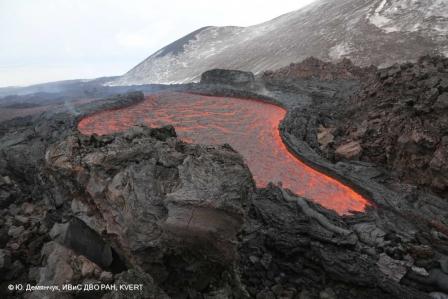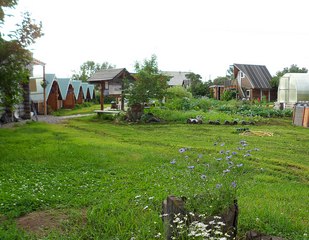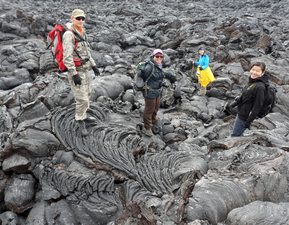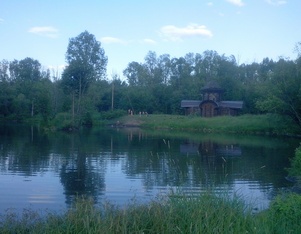Automobile tour to Tolbachik volcano (with the ascent of Flat Tolbachik volcano) in 5 days
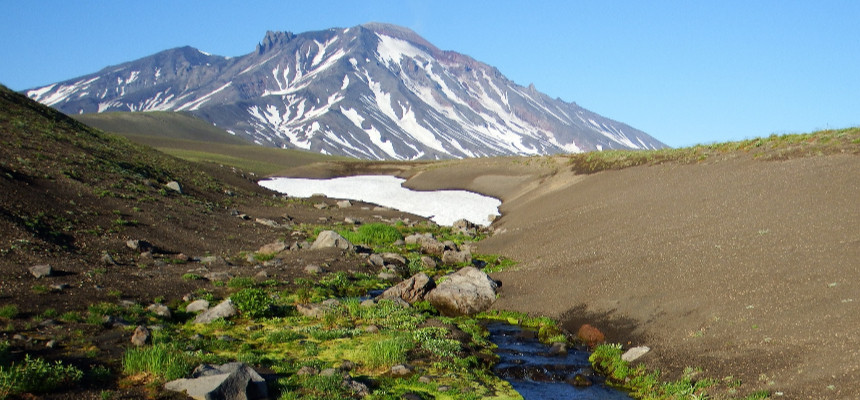
- General information
- Detailed program
- Necessary equipment
- Tour cost
Short description
Route: Petropavlovsk-Kamchatsky - Milkovo settlement - Kozyrevsk village - Tolbachik dale - Plosky Tolbachik volcano - Petropavlovsk-Kamchatsky.
A five days' trip into the heart of Kamchatka will let you look into the crater of one of the most interesting volcanoes of the peninsula, climb warm volcanic cones and walk on the lava field that appeared in the year 2013.
Additional information:
Ostry (Sharp) Tolbachik volcano (3682 m) and Ploskiy (Flat) Tolbachik volcano (3085 м) – two stratovolcanoes of Klyuchevskaya volcano group.
Great fissure volcanic eruptions (when the volume of lava, ashes and scoria exeeds1 km3) – is a rare natural event. They occur when magma flows up through cracks in the ground. Fissure eruptions are characterized by a curtain of fire, and by lava spewing out to a small height above the ground. Fissure eruptions can produce very heavy flows, though the lava is generally slow moving. In the historical period such great fissure eruptions were registered only seven times: twice in Iceland in 930 and 1783; twice in Mexico in 1759 and 1943; once on Canary Islands in 1730. The sixth and the seventh eruptions occures in Kamchatka in 1975 – 1976 and 2012 – 2013 in Tolbachik Dale.
The Great Tolbachik Fissure Eruption (GTFE) bagan in July 1975 and continued till December 1976 and was the most voluminous eruption of basaltic lava and tephra since the 1783-84 Iceland eruption. About 2 cubic kilometers of material (more than four times the volume of the largest historic eruption of Mauna Loa) were erupted from two major vent areas in the Tolbachik regional zone of cinder cones, a fissure system extending more than 38 kilometers south-southwest of Ploskiy Tolbachik volcano. It resulted in the appearance of the so called Nothern and Southern breakthroughs. Activity at the Northern breakthrough was unusually violent for a basaltic eruption, generating a tephra-laden column 8 to 13 kilometers high that persisted throughout the development of three large cinder cones 330 m., 300 m. and 150 m. high as well as voluminous flows. In 17 months the landscape of Tolbachik Dale changed drastically: the vegetation was destroyed, rivers and lakes were covered by ash. It converted an area of about 400 km2 into a lifeless desert.
According to seismic data on November 27, 2012 Tolbachik Fissure Eruption started. The eruption was named as "The Institute of Volcanology and Seismology 50th Anniversary Fissure Tolbachik Eruption" (FTE-50). It lasted almost 11 months until December 2013. В результате излияния лавовых потоков и стромболианской активности заметно изменился ландшафт Толбачинского дола — появились целые поля, представляющие собой нагромождения лавы высотой до 15 метров, продолжающие наращиваться за счёт новых прорывов. The eruption started from two vents, named after eminent Russian volcanologists - Menyailov and Naboko vents, and after three days all activity concentrated in the lower (Naboko) vent. Three new lava fields were formed with a total area is about 36 km2. Two scientific bases had been destroyed by lava flows. The road to Tolbachinsky Dol was blocked..
If this trip is too long for you, we offer you to look through the shorter variant of the program.
Day 1: PKC – Kozyrevsk
Transfer by all-terrain bus to Kozyrevsk village, on the bank of the river Kamchatka. Lunch en route in the old Cossaсk settlement Milkovo. Arrival at the village of Kozyrevsk. Accommodation at a private hotel, in wooden houses on a specially prepared ground.
Kozyrevsk is one of the oldest settlements of the Kamchatka region. It was founded in the 18-th century on the site of an ancient village of Itelmen – the indigenous inhabitants of the peninsula. It is situated in the valley of the river Kamchatka, 492 km to the north of Petropavlovsk-Kamchatsky. It is also only 37 – 48 km away to the west of the active volcanoes: Ushkovsky (3943 m), Besymyanny (2882 m) and the highest active volcano of Europe and Asia – Klyuchevskaya Sopka (4850 m). A big Neolithic site – the remains of earth-houses, about 800 years of age, was discovered by archeologists in immediate proximity to Kozyrevsk.
Walking excursion around the village. Typical Russian sauna (banya).
Dinner. Instructions for the next day. Overnight stay in wooden huts.
Day 2: Kozyrevsk – Tolbachik valley – the spot of The Great Tolbachik Fissure Eruption of 1975 – 1976
Breakfast. We drive to Tolbachik dale to the height of about 1200 m asl. Excursion to the slag cones of the Northern explosion that appeared during the Great Tolbachik Fissure Eruption in 1975 – 1976. Climbing a new volcanic cone.
The new cones look like mini-volcanoes up to 200 meters high.
Lunch. Excursion to the "Dead Forest" and exploration of the old lava caves in the crater of the cone Zvezda (The Star). Transfer to the site of the base camp.
Assembling the tents. Dinner. Instructions for the next day.
Overnight in tents in the camp.
Day 3: Ascent to Flat Tolbachik volcano (3085 m)
Breakfast. Ascent to the top of Plosky (Flat) Tolbachik volcano (3085 m asl.). You will be en route 10 to 12 hours. Lunch on the volcano slope.
As a result of The Great Tolbachik Fissure Eruption the bottom of the crater was destroyed and a 500 meters deep caldera was formed. It is now 1,7 km wide.
Observe the crater and the surrounding landscape.
Return to the base camp. Dinner. Instructions for the next day.
Overnight stay in tents in the base camp.
Day 4: The Tolbachik fissure eruption of 2012 – 2013
Breakfast. Walking excursion to Menyailov’s crater and the eruptive fissure – the central spot of the eruption of 2012 – 2013 (which was given the name of 50-th anniversary of the Institute of volcanology and seismology FED RAS). Exploration of the site: large fresh lava flows, caves (lava tubes), stone sculptures and piles upon piles of the frozen lava.
When studying the aftereffects of the eruption of the year 2013 the scientists discovered diamonds, that were formed as a result of the synthesis of carbonic gasses.
Lunch en route.
Return to the base camp. Dinner. Instructions for the next day.
Overnight stay in tents in the base camp.
Day 5: Tolbachik valley – PKC
Breakfast. Packing up the camp. Drive to Petropavlovsk-Kamchatsky.
Lunch in the settlement of Milkovo.
Arrival at Petropavlovsk-Kamchatsky.
- backpack for your personal staff;
- comfortable trekking shoes / trekking boots with high tops;
- gaiters;
- light shoes to change;
- warm hat;
- gloves;
- windproof (fleece) jacket;
- waterproof jacket or raincoat;
- sleeping bag;
- trekking poles (if necessary);
- sunglasses, sunburn treatment cream;
- personal hygiene products, towel;
- bathing suit;
- mosquito spray;
- individual medical kit;
- head torch.
Cost of the tour for the year 2020 is 780 Euro per person.
* The tour price includes:
- tourist voucher to apply for visa;
- FSB coordination;
- transport services according to the program;
- accompaniment (guiding services);
- interpreter services (English or German-speaking guide);
- services of a cook;
- mealsen route;
- provision with tents and sleeping pads;
- use of all group tourist equipment and inventory;
- recreational services of the nature parks of Kamchatka;
- accident insurance.
* NOT included in the price are:
- air tickets to Petropavlovsk-Kamchatsky and back;
- meal in Milkovo settlement;
- hotel accommodation in Kozyrevsk village (about 1500 roubles per Person);
- alcoholic beverages;
- provision with sleepeing bags.
* The price of the tour may vary depending on your wishes and the type of accommodation!




